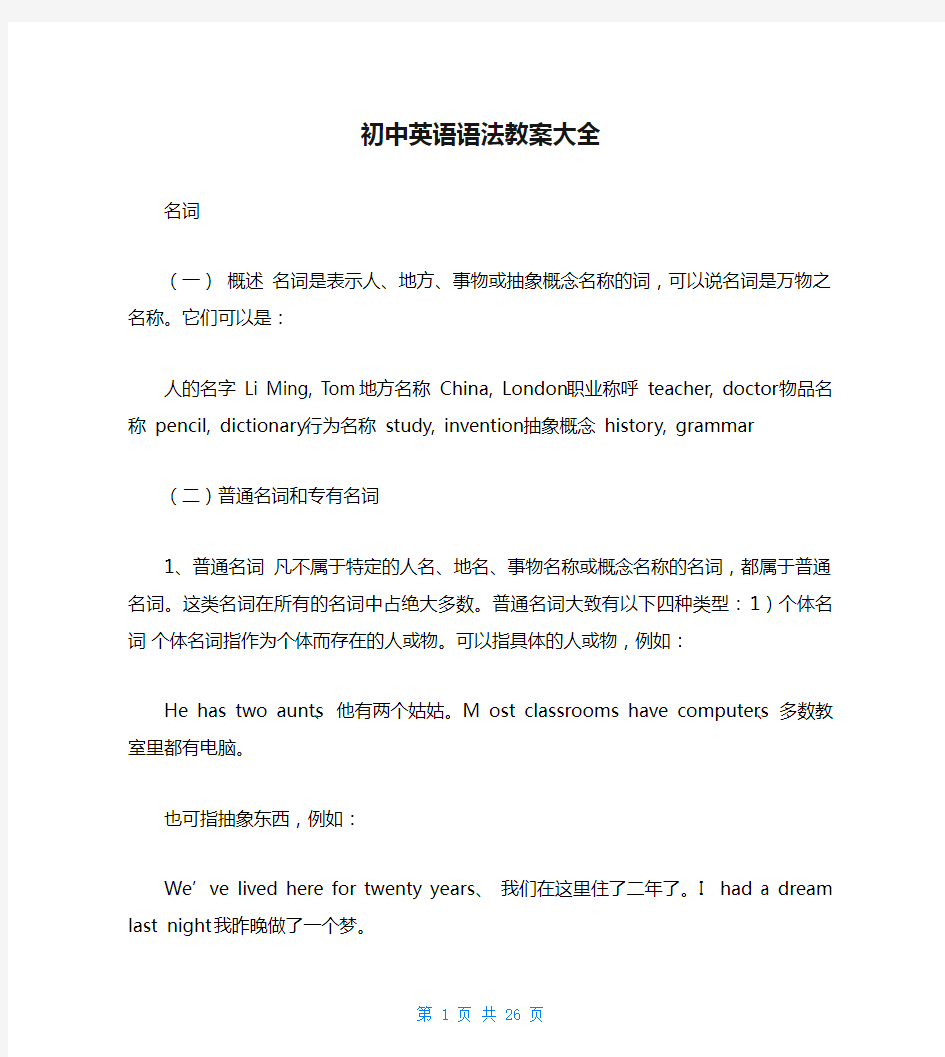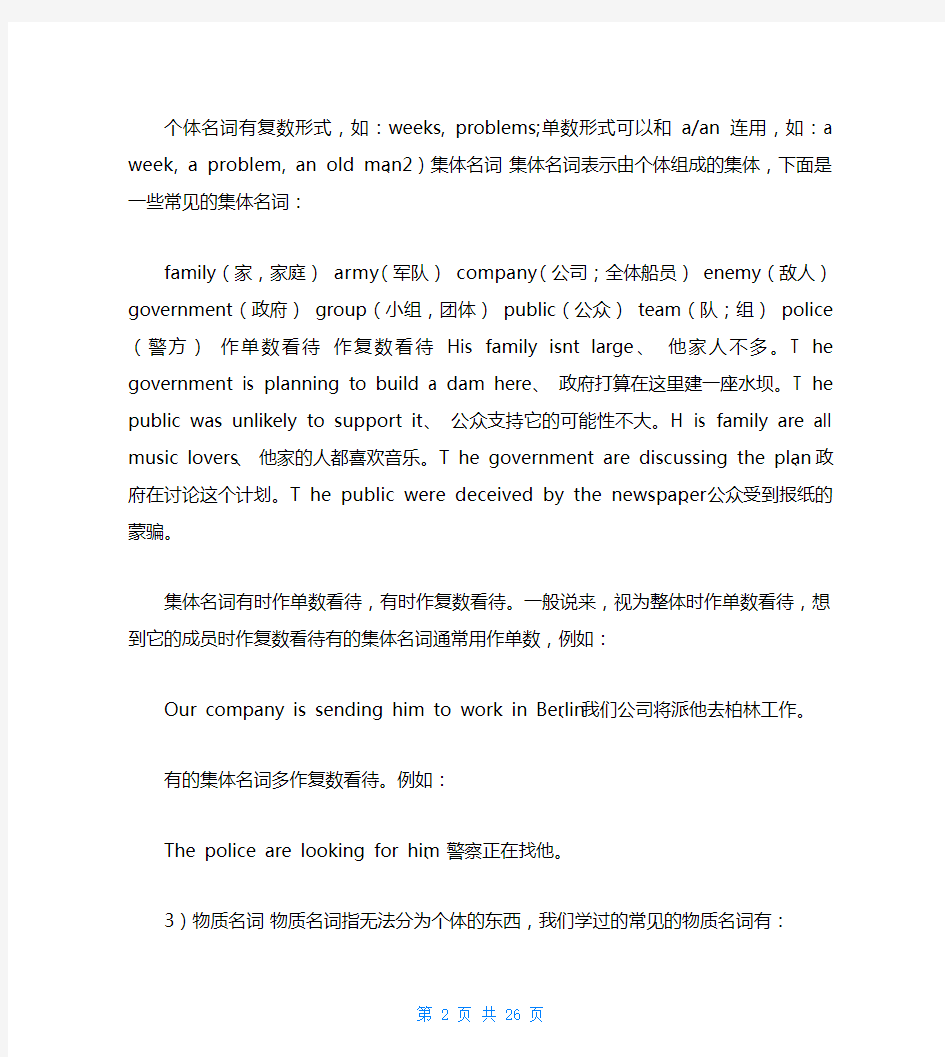

初中英语语法教案大全
名词
(一)概述名词是表示人、地方、事物或抽象概念名称的词,可以说名词是万物之名称。它们可以是:
人的名字 Li Ming, Tom 地方名称 China, London 职业称呼teacher, doctor 物品名称 pencil, dictionary 行为名称study, invention 抽象概念 history, grammar
(二)普通名词和专有名词
1、普通名词凡不属于特定的人名、地名、事物名称或概念名称的名词,都属于普通名词。这类名词在所有的名词中占绝大多数。普通名词大致有以下四种类型:1)个体名词个体名词指作为个体而存在的人或物。可以指具体的人或物,例如:He has two aunts、他有两个姑姑。M ost classrooms have computers、多数教室里都有电脑。
也可指抽象东西,例如:
We’ve lived here for twenty years、我们在这里住了二年了。I had a dream last night 我昨晚做了一个梦。
个体名词有复数形式,如:weeks, problems;单数形式可以和a/an连用,如:a week, a problem, an old man、2)集体名词集体名词表示由个体组成的集体,下面是一些常见的集体名词:
family(家,家庭) army(军队) company(公司;全体船员) enemy(敌人) government(政府) group(小组,团体)public(公众) team(队;组) police(警方)作单数看待
作复数看待 His family isnt large、他家人不多。T he government is planning to build a dam here、政府打算在这里建一座水坝。T he public was unlikely to support it、公众支持它的可能性不大。H is family are all music lovers、他家的人都喜欢音乐。T he government are discussing the plan、政府在讨论这个计划。T he public were deceived by the newspaper、公众受到报纸的蒙骗。
集体名词有时作单数看待,有时作复数看待。一般说来,视为整体时作单数看待,想到它的成员时作复数看待有的集体名词通常用作单数,例如:
Our company is sending him to work in Berlin、我们公司将派他去柏林工作。
有的集体名词多作复数看待。例如:
The police are looking for him、警察正在找他。
3)物质名词物质名词指无法分为个体的东西,我们学过的常见的物质名词有:
beer, cloth, coal, coffee, coke, cotton, ice, ink, jam, juice, meat, medicine, metal, milk, oil paper, rain,
salad, salt, sand, snow, soup, steel, sugar, tea, water, wine, wood, wool等。
一般说来,物质名词是不可数折,因而没有复数形式。但有
一些特殊情况:
a、有些物质名词可用作可数名词,表示“一份”,“一
杯”:
Tree beers, please、请来三杯啤酒。A chocolate ice-cream for me、给我一份巧克力冰淇淋。b 、有此物质名词可作
可数名词,表示“一种”:
It was a special tea which tasted of orange
blossoms、这是一种特别的茶,有桔子花叶。I t was a delicious wine、那是一种美味的红酒。c 、个别物质名词可用
于复数形式或有特殊意义:
It was now the time of the spring rains、现在是春天
雨季的时候。H ere are the snows of last year、这是去看的
积雪。d 、抽象名词抽象名词主要表示一些抽象概念,一般不可数,因此没有复形,前面也一般不加不定冠词a/an。常见的抽象
名词有:
age, anger, beauty, childhood, death, duty, fear, fun, happiness, health, help, history, industry, joy, labour, love, luck, music, nature, peace, pleasure, power, safety,
silence, sleep, time, training, travel, trust, truth, waste, weather, work, worth, youth等。
在多数情况下,这种名词常用于单数形式,不加任何冠词。例如:
safety first! 安全第一!It’s wonderful weather、天气好极了。
但有时也加定冠词the,或不定冠词a/an、例如:
I shall never forget the beauty of that lake、我永远不会忘记那个湖的美丽。T here’s a beauty in simplici ty、朴实之中有一种美。
2、专有名词专有名词主要指人名、地名及某些类人和事物专有的名称。例如:1)人名:Mary, Mrs Green, Zhanghua2)地名:Beijing, West Lake3)某类人的名称:Americans, Russians4)某些抽象事物的名称:English, Chinese5)月份、周日及节日名称:May, Saturday, Easter6)书名、电影及诗歌的名称:Cone with the Wind7)对家人等的称呼:Mum, Dad, Uncle Tom 专有名词的第一个字母要大写。
(三)可数名词和不可数名词名词按所表示的事物的性质分为可数与不可数名词两类。可数名词有复数形式,不可数名词一般没有复数形式。
普通名词中的个体名词和集体名词一般是可数的,所以它们又可称为可数名词。可数名词单数往往要同不定冠词a或an连
用,复数则要使用其复数形式。例如:单数复数 a country a class a sheep a tomato countries classes sheep tomatoes 普通名词中的物质名词和抽象名词及专有名词一般是不可数的,这些名词又可称为不可数名词。不可数名词不能用不定冠词修饰,也不存在复数形式,如ice (冰),water (水), rice (稻子)等。
在英语中个别名词既可以作不可数名词,又可以作可数名词。但由于用法不同,它们的意思往往也不大相同,对这些名词要特别注意。
作不可数名词作可数名词 glass 玻璃 paper 纸张 time 时间 work 消息玻璃杯;镜子;眼镜报纸;文件;考卷次数;时代单词;话语例如一般说来,汉语和英语对某一个名词是否可数的看法基本上是一致的。但也有不少名词在汉语中常被用作可数名词,而在英语中却绝对是不可数名词,对这些名词也要特别注意,发如:fun ,work ,advice ,weather ,homework ,news ,money ,information ,bread ,hair ),chalk ,furniture 等。
(四)可数名词复数形式的构成可数名词的复数形式通常是在单数形式后加-s或-es,现将其复数的一般构成方法及读音列表如下:
情况构成方法例词读音一般情况在词尾加-
sdesk→desks map→mapss在元音私浊畏音后发[z] 以s, x, ch,
sh结尾的词在词尾加-es bus →buses box→boxes
watch→watches fish→fishes es发[iz]音以辅音字母加y结尾的词变y为I再加-es family→families factory→factories party→partiessday→days boy→boys key→keyses
knife→knives life→lives wife→wives half→halveses potato→potatoes tomato→tomatoes
h ero→heroessradio→radios zoo→zooss。如:photo→photos, piano→pianos 等。
有些以f结尾的名词变为复数时也只加-s。如:handkerchief→handkerchiefs, roof→roofs等。
英语中还有不少名词的复数形式是不规则的,必须把它们牢记在心。如:man→men, woman→women, Frenchman→Frenchmen, child→children, tooth→teeth, foot→feet, goose→geese, mouse→mice, sheep→sheep, deer→deer, fish→fish等。
(五)名词的所有格在英语中,有些名词的词尾可以加上’s,用来表示所有关系,这种结构称为名词的所有格。
1、名词所有格的构成名词所有格的构成一般有以下三种情况:1)如果名词是单数,只在词尾加’s。
例如:
the boy’s schoolbag 这男孩的书包the worker’s shoes 这个二人的鞋2)复数名词如果以s结尾,只加’(在s的右上角)即可如:
the teachers’ office老师们的办公室the students’ classroom 学生们的教室3)复数名词如果不以s结尾,则在词尾加’s 如:
Women’s Day 妇女节the People’s Park 人民公园
2、名词所有格的用法名词的所有格主要有以下五种用法:1)表示人成动物与其他的人、动物或事物的所有关系。
例如:
He is Mary’s younger brother、他是玛丽的弟弟。T hey are reading Lei Feng’s Diaries、他们在读雷锋的日记。
2)表示时间、距离、国家、城市等名词与其他事物的所有关系。
例如:
Our school is half an hour’s walk from here、我们学校离这儿步行有半小时的距离。B eijing is China’s
capital、北京是中国的首都。
3)表示无生命东西的名词的所有关系,一般使用与of构成的短语结构。
例如:
The front door of the house was painted red、那屋子的前门被漆成了红色。T here is a map of the world on the front wall of our classroom我们教室前面的墙上有一幅世界地图。
4)名词所有格后面跟地点,往往要将地点名词省略。
例如:
My sister often goes to my uncle’s、我的妹妹经常到
我叔叔家去。Y ou look ill、You’d better go to the doctor’s、你脸色不好,最好去看看病。
5)被名词所有格所修饰的词,如果前面已经提出到过,一般
可以省略。
例如:
I am using my dictionary、 You ca n use Tom’s、我们
字典我正在用,你可以用汤姆的。O ur bedroom is much larger than John and Dick’s、我们的寝室比约翰私迪克的大得多,(六)可数名词和不可数名词的数量表达
1、两种名词都有能修饰的数量词有:some, any, plenty of,
a lot of, lots of等。
例如:
Please give me some paper、请给我一些纸。I don’t want to borrow any magazines、我不想借什么杂志。
2、用来修饰可数名词的数量词有:many, several、
hundreds of, a number of, a pair of, a few, few等。
例如:
You have made quite a few spelling mistakes in your composition、你的俄文中有很多拼写错误。S everal days
later, a group of students went to help the old man、几天以后,一群学生去帮助了那位老人。
3、用来修饰不可数名词的数量词有:much, a great deal of, a bit of, a drop of, a piece of, quite a little, little,等。
例如:
I want a piece of red chalk、我想要一支红粉笔。P lease give her a bit of bread、请给她一点面包。
(七)名词的用法
1、作主语例如:The radio says that it may stop raining later、广播说一会儿雨可能会停。
2、作表语例 Class3 were the winners、三班获胜了
3、作宾语例如:
I told him a story、我给他讲了个故事。
4、作宾语补足语例如:
He named her Jenny、他给她取名詹妮。
5、作定语例如:
We are discussing the population problem、我们正在讨论人口问题。
6、作状语例如:
He sat here a long time、他坐在这儿很久了。
7、与介词组成词组例如:
I am working hard on my Chinese、我正在努力学习汉语。
8、作介词宾语例如:
Give the money to your sister、把钱给你姐冠词重点知识归纳及讲解
(一)概说
1、冠词是一种虚词,不能独立担任一个成分,只能附着在一个名词上,帮助说明其词义。英语中有两个冠词:1)定冠词
the2)不定冠词a/an 定冠词the通常读作[],在元音前读作[i],特别强调或单念时读作[i:]。
不定冠词在元音音素开始的单词前用an这个形式,读作[n];在其他情况下则使用a,读作[]。
2、冠词的基本意义不定冠词a/an与数词one同源,表示“一个”的意思,用在可数名词单数前。
例如:She is a nurse、她是个护士。H e is an Englishman, with an Irish wife、他是一位英国人,有一个爱尔兰妻子。
定冠词the,与this同源,有“这(那)个”的意思,但比较弱,表示一(几)个特定的人或东西,有时可译作“这个(些)”或“那个(些)”。
例如:
That’s the book you want、这就是你要的那本书。W ho’s the yo ung man over there? 那边那个年轻人是谁?
但在很多情况下,“这”或“那”这类词在译文中并不出现。
例如:
Put it on the table、把它放在桌上。S hut the door, please、请把门关上。
3、特指和泛指一般来说,名词有特指和泛指两种情况,请比较下面的句子:
A gentleman is asking to see you、有位先生要求见你。(泛指) Ask the gentleman to come in、请那位先生进来。(特指)在特指时一般前面要加定冠词,而泛指时则有三种情况:1)在可数名词单数前加不定冠词。
例如:
She sent me a postcard 她寄给我一张明信片。
2)在可数名词复数前可不加冠词,可使用some, any这类词。
例如:
These are new words、这些是生词。S he sent me some flowers、她送给我一些花。
3)在不可数名词前多不加什么,有时也可加some, any等。
例如:
It’s lovely weather、天气真好。D o you want any sugar in your tea? 你茶里要放点糖吗?
Give us some help、给我们一些帮助。
(二)不定冠词的基本用法
1、泛指某一类人或事物中的一个,代表某一类别(不一定译为“一”)例如:
His father is a doctor、他父亲是医生。
2、代表某一类人或事物,相当于any(+名词)(不必译为“一”,但必须用a,表示类别)例如:
A horse is a useful animal、马是有用的动物。
3、指某人或某物(不是指某一类),但不具体说明何人或何物(一般译为“一”)例如:
This book was written by a worker、这本书是一位工人写的。
4、表示数量,有“一”的意思,但数的概念没有one强烈(一般译为“一”)例如:
Wait a moment、等一下。
5、表示单位,相当于“每”的意思例如:
We have three meals a day、我们每日吃三餐。
6、用于某此固定词组中例如:
a few, a little, a bit (of), a lot of等。
(三)定冠词的基本用法
1、特指某(些)人或某(些)事物例如:
Give me the book、把那本书给我。
2、指谈话双方都知道的人或事物例如:
Where is the doctor? 医生在哪儿?
3、再次提到上文提到过的人或事物例如:
I bought a dictionary yesterday、 The dictionary is at home、昨天我买了一本词典。词典在家里。
4、用在大家所熟悉的、世界上独一无二的事物例如:
The earth is bigger than the moon, but smaller than the sun、地球比月亮大,但比太阳小。
5、用在序数词和形容词最高级前例如:
Mr Wang teaches the first class、王先生上第一节课。O f all the stars the sun is the nearest to the earth、在所有的恒星中,太阳离地球最近。
6、用在单数可数名词,表示某一类人或事物例如:The horse is a useful animal、马是有用的动物。
7、与下列专有名词连用1)在江、河、湖、海、群岛、山脉的名称前例如:
the Changjiang River, the Great Lake2)在姓氏的复数名词前,表示夫妇二人或全家人例如:
The Greens are sitting at the breakfast table、格林一家人正围坐在早餐桌旁。
8、和某些形容词连用,表示一类人例如:
the old 老人 the young 年轻人 the rich 富人 the poor 穷人 the sick 病人 the dead 死人
9、在一些习惯说法中 the east (west, south, north)
in the morning (afternoon, evening)
on the left (right)
in the end go to the cinema
(四)不用冠词的几种情况
1、在专有名词,抽象名词和物质名词前例如:
Have you ever been to Shanghai? 你到过上海吗?
We love science、我们爱好科学。
2、在表示一类人或事物的复数名词前例如:
Girls can be scientists、女孩子可以当科学家。
3、在季节、月份、星期、一日三餐的名称前例如:
It is hot in summer、夏天天气热。H ave you had breakfast? 你吃过早饭没有?
It’s Tuesday, August the22nd、今天是八月二二日,星期三。
4、称呼语或表示头衔,职务的名词前例如:
What’s the matter with you, Mike? 怎么啦,迈克?
He is headmaster of our school、他是我们学校的校长。
5、学科和球类运动的名称前例如:
We study English、我们学习英语。D o you like to play football? 你喜欢踢足球吗?
6、名词前已有用作定语的this, that my, your, some, any, no, whose, every, each等代词时,不用冠词例如:
That is her bike。
那是她的自行车Each student in his class studies
hard、这个班的每个学生都努力学习。
7、在某些固定词组的名词前例如:
at home, at night, after school, by bus, in bed, in town, in front of, go to school, go to bed等。代词
一、内容概述
1、代词的作用严格地讲,代词是代替名词的,在句子中起
名词的作用,可用作:1)主语例如:
This is our new home、这是我们的新家。W ho is on the phone? 谁在打电话?2)宾语例如:
Take good care of yourself、 We should help each other、3)表语例如:
That’s not mine、 Who is it? —It’s me、4)同位语
例如:
We both live in the dormitory、 He ate them all、5)
呼语例如:
Be patient, everybody、
2、代词的分类代词通常可分为以下八类:1)人称代词(I, you, he , we等)2)物主代词(our, your, their, his等)
3)反身代词(myself, ourselves, yourself, itself等)4)相互代词(each other, one another)5)指示代词(this, that, these, those等)6)疑问代词(who, what, which, whose等)7)关系代词(who, that, which, whose等)8)不定代词(both, all, some, any等)
二、重点知识归纳及讲解
(一)人称代词
1、人称代词的单数、复数和主格、宾格数格人称单数
复数主格宾语主格宾格
第一人称 I 我 me we 我们 us
第二人称 you 你 you you 你们 you
第三人称 he 他 she 她 it 它 him her it 他们 they 她们
它们 them
2、人称代词的用法1)人称代词的主格在句子中充当主语例如:
I am studying English now、我现在正在学英语。W e
love our country、我们热爱我们的国家。
如果有几个人称代词并列充当主语,它们的顺序是:
单数形式 you, he and I 复数形式 we, you and they2)人
称代词的宾语在句子中充当宾语、介词宾语或表语。
例如:
Can you help us? 你能帮助我们吗?
We are waiting for them、我们正在等他们。W ho is there? It’s me、是谁呀?是我。
(二)物主代词物主代词用来表示人和物之间的所有关系,这类代词有形容词性物主代词和名词性物主代词两种,并有不同的人称和单复数之分。
2、形容词性物主代词与名词性物主代词的主要用法区别1)形容词性物主代词不能独立使用,只作定语,用来修饰后面的名词。
例如:
My parents are both doctors、我的父母都是医生。W e saw a film yesterday、 Its name was Speed、我们昨天看了一场电影,片名是《生死时速》。
2)名词性物主代词应独立使用,后面不跟名词,相当于形容词性物主代词+名词,它们在句中可以作主语、宾语或表语。
例如:
Is this her pen? No, hers is red、(主语)这是她的钢笔吗?不,她的是红色的。L et’s clean their room first, and then clean ours、(宾语)咱们先打扫他们的房间,然后再打扫我们的。T hese letters are his、(表语)这些信是他的。
(三)反身代词反身代词用来表示反射或强调。
1、反身代词的形式人称一二
三
单数 myself yourself himself herself itself 复数ourselves yourselves themselves
2、反身代词的用法1)在句子中作宾语,表示动作回射到动作的执行者本身。
例如:
My grandmother is too old to look after herself、我奶奶年纪太大了,照顾不了她自己。L ei Feng was always ready to help others, he never thought of himself、雷锋总是乐于帮助别人,从不考虑自己。
2)在句中作名词或代词的同位语,用来加强语气,常可译为“亲自”、“本人”等。在这种情况下,反身代词可以紧跟名词或代词之后,也可以放到句末。
例如:
We ourselves will build the factory、我们将自己建造这个工厂。H e spoke to me myself、他对我本人说话。
3)反身代词在实际运用中可构成许多常用词组。
例如:
by oneself 亲自 for oneself 为自己 call oneself 称自己 teach oneself 自学 help oneself to 随意吃 lose oneself
迷路 speak to oneself 自言自语 seat oneself 就座 make oneself understood 让别人懂得自己的意思
(四)指示代词指示代词是表示“这个”、“那个”、“这些”、“那些”等指示概念的代词,如:this, that, these, those等。英语中指示代词的用法同汉语中的情况相似。this和these一般用来指较近的事物,that和those则指较远的事物。
指示代词可以充当句子中的主语、定语、宾语或表语。
例如:
This is a difficult question、这是个难题。T hat basketball isn’t ours、那个篮球不是我们的。D o you like these? 你喜欢这些吗?
(五)不定代词不定代词是不指明代替任何特定名词的代词。
1、不定代词有以下形式:
some, somebody, someone, something, any, anybody, anyone, anything, nobody, nothing, all, both, neither, none, either, each, everybody, everyone, everything, other, another, much ,one
2、不定代词在句子中的作用:1)作主语例如:
Everyone has come、Let’s begin、大家都到了,我们开始吧。B oth of his parents are doctors、他的父母都是医
生。O ne is the teacher, the others are students、一人是老师,其余的是学生。
2)作宾语例如:
This one is too small, please show me another、这个太小,请另外拿一个给我看看。P lease introduce me to the others、请把我介绍给所有其他的人。
3)作表语例如:
That’s all for today、今天就到这儿吧。I t’s too much for me、这件事非我力所能及。
3、常见不定代词的用法讲解1)some和any a、some常用于肯定句,any多用于否定句,疑问句或条件状语从句,两者都可以代替可数或不可数名词。
例如:
Some say yes and some say no、I don’t like any of them、 Does any of them know this? b、如果在提问时期待对方肯定回答,或鼓励别人说yes时,疑问句中的不定代词要用some,不用any。
例如:
Would you like some of the tickets? 你想要些票吗?
c、在强调“任何一个”意思的时候,any也可用于肯定句。
例如: